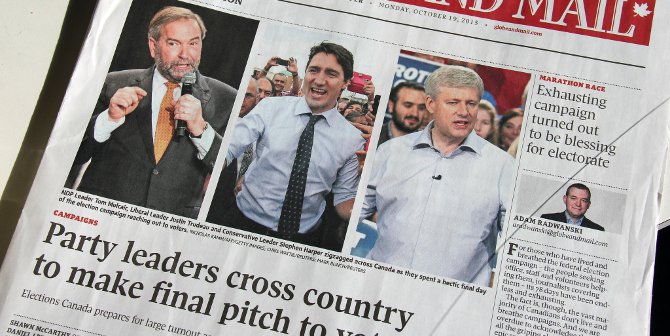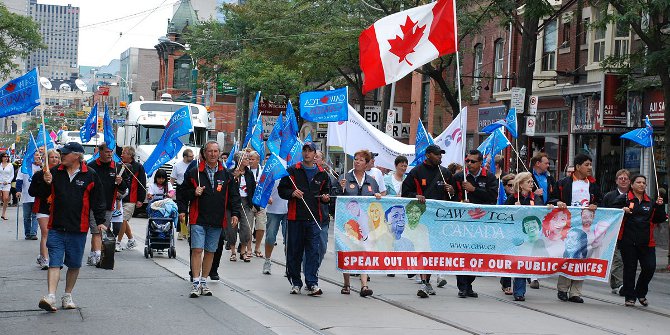 Last month, Justin Trudeau led Canada’s Liberal Party to victory in the country’s federal election. Cristine de Clercy reviews the election campaign of the three major parties, and examines how the party’s leaders managed their party’s messaging to voters. She writes that in contrast to incumbent Prime Minister and Conservative Party leader, Stephen Harper’s stale, ‘more of the same’ messaging and the diffuse and unfocused messaging of the New Democratic Party, Trudeau’s positive message on the economy and the middle class was clear and continued to be appealing to voters throughout the campaign.
Last month, Justin Trudeau led Canada’s Liberal Party to victory in the country’s federal election. Cristine de Clercy reviews the election campaign of the three major parties, and examines how the party’s leaders managed their party’s messaging to voters. She writes that in contrast to incumbent Prime Minister and Conservative Party leader, Stephen Harper’s stale, ‘more of the same’ messaging and the diffuse and unfocused messaging of the New Democratic Party, Trudeau’s positive message on the economy and the middle class was clear and continued to be appealing to voters throughout the campaign.
To lead is to communicate; this behavior is fundamental to successful political campaigns, and Canada’s recent federal election was no exception. The leader’s messaging guides each team of candidates, ensuring the core ideas are repeated faithfully in thousands of local conversations with voters and community media. Party leader communications serve also to help focus and co-ordinate campaign teams and the volunteers supplying critical resources on the ground. For voters and the media, leaders’ messages usually are the key source of party information.
The unusual length of Canada’s 2015 federal election challenged party leader messaging in two ways. First, the 78 day campaign meant leaders faced a large challenge in communicating a consistent theme while avoiding being pulled “off message” by unexpected events and news headlines. A second challenge was to keep the central message fresh, and relevant to the campaign’s context, to engage citizens and attract media coverage. How well did each party leader address these pressures? The leaders of the Conservative and New Democratic parties, Stephen Harper, and Thomas Mulcair, had trouble managing these challenges, while the Liberal leader was much more successful in keeping his message consistent, focused and relevant.
In early August, Conservative Prime Minister Stephen Harper began the campaign by emphasizing his proven leadership ability and the party’s commitment to maintaining a steady economic approach. He stayed on message during the resumption of Senator Mike Duffy’s fraud trial despite much media scrutiny. However, despite the virtues of his confident, consistent communications, by mid-September the message seemed stale. “More of the same” made for rather boring headlines, and so reporters and voters focused on how the Conservatives were responding to several attention-grabbing media stories, such as poor economic numbers and the Syrian refugee crisis. By the campaign’s halfway point in September the Tories clearly were losing ground in opinion poll standings and insiders were complaining they were off message. A campaign reset was undertaken: Harper began talking more actively about the other leaders’ deficiencies, and emphasizing his controversial position that women should not be allowed to wear a face veil at citizenship ceremonies. Harper ended the campaign by focusing on public security issues, likely to try to shore up his base of support.
Image credit: Canadian Pacific (Flickr, CC-BY-NC-2.0)
New Democratic Party leader Thomas Mulcair’s main message, at the outset, emphasized the real possibility his party would replace the governing Conservatives. Buoyed by the NDP’s success in taking government in Alberta, and his record as Official Opposition leader, he positioned his party as the best choice for change. “I want to speak to every Canadian who thinks Mr. Harper’s government is on the wrong track, to every Canadian who is looking for change in Ottawa,” he said in early August. Mulcair communicated a dignified but cautious “front runner” stance in the first leaders’ debate. However, as the campaign wore on he devoted much attention to using headline issues to try to further undermine the Tories. He spent much time speaking about the Harper government’s failure to manage the Syrian refugee issue, the problems within the Trans-Pacific Partnership trade deal, and the right of women to wear a niqab. The NDP leader’s messaging became diffused across a number of issues. Moreover, when he tried to restore focus late in the campaign, he seemed out of touch. In the context of opinion polls showing marked decline in support – to third place – Mulcair continued to repeat the NDP was the most competitive alternative, needing only 35 more seats to replace the Conservatives.
Liberal Party leader Justin Trudeau began campaigning with a positive message, emphasizing his party was the only one with a real plan to strengthen the middle class and the economy. He consistently reiterated this theme and while he commented on several headline issues such as the Trans-Pacific Partnership deal and the Syrian refugee issue, he managed to avoid becoming enmeshed in these issues and so being pulled off message. At the same time, he addressed Harper’s charge that he was “just not ready” to govern in part by aggressively challenging the other leaders , and defending the integrity of citizenship during the Munk leaders’ debate by asserting Canadians “are kind, generous, open minded, optimistic and know in their heart of hearts that a Canadian is a Canadian is a Canadian.” As his third-place party moved up in poll standings, Trudeau remained on message. Although he, like Mulcair, defended the right of women to wear the niqab, he communicated this position clearly, and without muddying his messaging or sacrificing the focus of his communications. Justin Trudeau concluded the campaign with much the same message he had begun with: only the Liberals will help people by raising taxes on the wealthiest citizens – Mulcair and Harper will not.
The eleven-week long campaign amply demonstrates the difficulties party leaders face in articulating consistent, responsive communications. The Liberal party’s majority win owes much to adroit party leadership in managing the message across a protracted election period.
This article is based on a paper in the free ebook, “Canadian Election Analysis 2015: Communication, Strategy and Democracy.“
Please read our comments policy before commenting.
Note: This article gives the views of the author, and not the position of USAPP – American Politics and Policy, nor the London School of Economics.
Shortened URL for this post: http://bit.ly/1O5eQ0s
_________________________________
 Cristine de Clercy – Western University
Cristine de Clercy – Western University
Dr. Cristine de Clercy is a Co-Director of the Leadership and Democracy Lab, and Associate Professor in Political Science at Western University in London, Canada. She specializes in studying Canadian politics, election law and political leadership.







